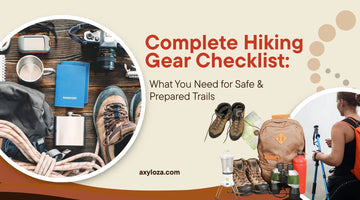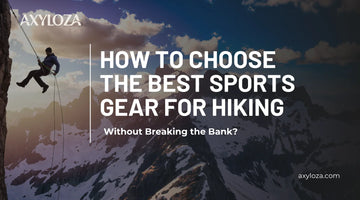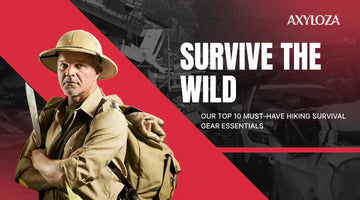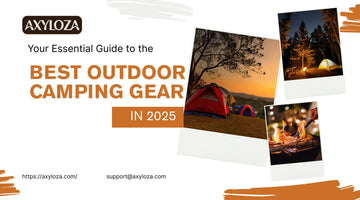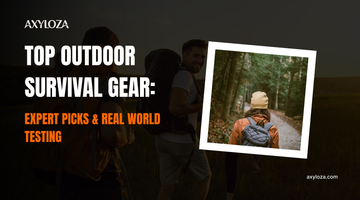Why Having a Complete Hiking Gear Checklist Matters?
The importance of preparedness and safety on trails
Every hike has its surprises. A sudden downpour, rocky ground, or a blister that slows you down can change the mood of your trip quickly. This is where a hiking gear checklist proves its worth. It’s not just about comfort; it’s your backup plan when things don’t go as expected.
Think of it as a trail preparedness checklist. Having the right hiking safety equipment, like navigation tools, first aid supplies, and emergency shelter, means you can handle challenges without panic. It’s the difference between enjoying the trail and being caught unprepared.
How does the right gear improve your hiking experience?
Beyond safety, good gear makes the journey enjoyable. With the best hiking gear, you can focus on the views, the quiet of the forest, or the challenge of the climb, instead of worrying about sore feet or running out of water.
For those starting, hiking gear for beginners is designed to be simple and user-friendly. Men's hiking gear tends to emphasize durability and rugged features, while hiking gear for women usually prioritizes fit and flexibility. Even small extras, like a lightweight hammock or multi-tool, count as cool hiking gear that adds both fun and convenience.
Essential Hiking Gear for Every Trail

Footwear: Boots vs. Trail Runners
Your shoes are the foundation of your hike. Hiking boots provide ankle support and grip for rocky, uneven ground, making them the better choice for multi-day treks or when carrying heavy packs.
Trail runners, on the other hand, are lighter and breathable, ideal for shorter hikes on well-maintained paths. Waterproof styles are a smart choice in wet climates. Whatever you choose, footwear belongs at the top of any hiking equipment list.
Clothing: Layering Systems Explained
Weather changes quickly outdoors, so a proper layering system is key. Start with a base layer that wicks moisture away, add a mid-layer for insulation, and finish with a shell that blocks wind and rain.
When browsing men's hiking gear, durability often comes first. With the best hiking gear for women, comfort and ergonomic design usually take priority. Don’t forget smaller essentials like hats, gloves, and fresh socks; these are lifesavers against blisters and sudden chills.
Navigation tools: Maps, Compass, GPS
Even if you’re relying on a GPS or a hiking app, traditional tools like a map and compass should always be part of your hiking gear list. Batteries die, signals vanish, but paper maps never fail. In remote areas, these tools are your lifeline.
Safety and Emergency Equipment
First aid kit must-haves
Every hiking gear checklist should include a first aid kit tailored to your needs. Stock it with bandages, antiseptic wipes, blister pads, pain relievers, and tweezers. Add personal medication such as allergy tablets or inhalers. A kit like this is your first line of defense when accidents happen.
Emergency Shelter and Fire-starting tools
Conditions can change fast. Even on a day hike, an emergency shelter, a tarp, or a space blanket can make a difference. Pair it with fire-starting tools like waterproof matches or fire starters. Together, they keep you safe and warm in an unexpected overnight stay.
Whistles, Mirrors, and Communication Devices
Sound and light signals can save your life. A whistle, signal mirror, or headlamp can attract attention in emergencies. For long-distance treks, especially when carrying Appalachian trail hiking gear, a satellite messenger or personal locator beacon is invaluable. These are part of hiking survival gear you should not overlook.
Hydration and Nutrition Gear
Water bottles vs. hydration bladders
Hydration is essential: if no water, no hike. Water bottles are easy to fill and monitor, while hydration bladders let you sip hands-free as you move. On average, plan for 2–3 liters of water per person.
Portable Water Filters and Purification Methods
Streams may look clean, but untreated water carries risks. Adding a filter, purifier, or iodine tablets to your backpacking gear essentials ensures safe drinking water wherever you are.
Energy-Packed Snacks for the Trail
Food is fuel. High-energy snacks like nuts, dried fruits, or protein bars keep you going without adding bulk. For overnight treks, pack a lightweight stove or cooking kit as part of your hiking and camping gear to enjoy warm meals after a long day.
Backpacks and Packing Tips

Choosing the Right Backpack Size
Your backpack organizes your whole trip. For a short hike, a 20–30 liter pack is usually enough. Multi-day trips need 40–60 liters. Fit is important; hiking gear for women often includes backpacks designed with curved straps and shorter torso lengths for better comfort.
Organizing your Gear for Easy Access
Think of your backpack as a puzzle. Put heavier items, like food or water, close to your spine at mid-back height for balance. Keep maps, snacks, or your first aid kit in outside pockets for quick access.
Weight Distribution and Comfort Tips
Don’t just load your pack, adjust it. Tighten hip belts, shift straps, and walk a bit before setting off. Test your hiking camping gear setup on shorter hikes to ensure comfort before committing to long distances.
Optional But Useful Gear for Longer Hikes
Trekking Poles
For many, trekking poles are a game-changer. They reduce knee strain, add balance, and help you move more efficiently on steep climbs or descents. They’re often included in lists of top-rated hiking gear for good reason.
Multi-Tools and Repair Kits
A multi-tool is one of the most awesome hiking gear options you can carry. From cutting bandages to fixing zippers, its uses are endless. A bit of duct tape or a tiny sewing kit also works wonders in emergencies.
Lighting: Headlamps and Flashlights
Even if you’re back before sunset, carry a headlamp or flashlight. It’s one of those cool hiking gear items that feels optional until you need it. Always pack spare batteries.
Final Thoughts
A thoughtful hiking gear checklist transforms any hike, from a casual afternoon stroll to a challenging mountain trail, into a safer, more enjoyable adventure. With the right mix of essential hiking gear and extras like trekking poles or multi-tools, you’ll be ready for whatever the trail brings.
Start small, test your gear on shorter hikes, and refine your kit until it feels right. That way, by the time you tackle bigger challenges, your setup will be dialed in.
Looking for reliable gear? Check out Axyloza for the best hiking gear, from hiking gear for beginners to advanced options. Pack smart, stay safe, and enjoy every step of your journey.
FAQs
What is the most important gear to carry for hiking safety?
Navigation tools, a first aid kit, and reliable communication devices are core hiking essentials for safety.
How to choose the right backpack size for a day hike?
For short trips, a 20–30 liter pack works best. Make sure it fits your torso and has a secure hip belt.
Should you bring trekking poles on every hike?
Not necessary for flat trails, but very useful on uneven or steep paths.
What should be included in a basic first aid kit for hiking?
Bandages, antiseptics, blister pads, pain relievers, tweezers, and personal medications.
How to keep hiking gear lightweight but still prepared?
Go for multi-use items, ultralight versions of essential hiking gear, and remove non-essentials after weighing your pack.
How to stay safe if hiking in remote areas?
Carry hiking safety equipment like a satellite messenger, tell someone your plan, and avoid hiking alone.
